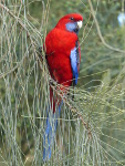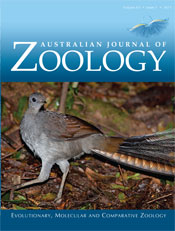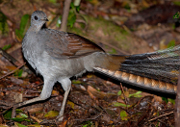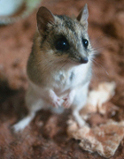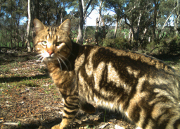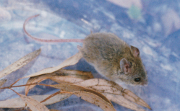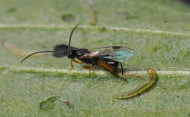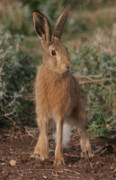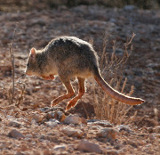Australian Journal of Zoology
Volume 63
Number 1 2015
Beak and feather disease virus (BFDV) is a serious threat to parrot populations globally. Here, we show that BFDV is a prevalent and widespread infection in wild populations of crimson rosellas (Platycercus elegans). In addition, we highlight the importance of sample type when conducting viral testing in wild birds.
Photo by Raoul Ribot.
We observed a marked increase in superb lyrebird (Menura novaehollandiae) numbers after a controlled burn in Guy Fawkes River National Park, New South Wales. The low-intensity fire cleared brush and low-level vegetation, and therefore may have attracted superb lyrebirds immediately after the fire due to ease of movement and foraging effort.
Photo by Gerhard Körtner.
We investigated the effect of unpredictable food availability on torpor use by stripe-faced dunnarts (Sminthopsis macroura). Long-term unpredictability in food supplies did not affect torpor-bout frequency compared to predictable food restriction. Instead, dunnarts appeared to adjust torpor frequency in response to the amount of food offered on each day.
Photo by Alex Leslie.
Cat abundance was significantly higher in two mesic sites that were baited for fox control for two decades than in two unbaited sites. Cat predation on a threatened species, the woylie (Bettongia penicillata), in the baited sites exceeded fox predation by more than 300%. Increased cat predation may become an unintended consequence of fox control for fauna protection elsewhere in Australia.
Photo by Neil Thomas.
We determined preferences of the Pilliga mouse, Pseudomys pilligaensis, for habitat attributes through phases of a population irruption, and characterised refuge sites. Its habitat selection changed with phases of the irruption. Mice preferred ground cover with higher proportions of sand and shrubs in the Low phase of the irruption.
Photo by Hideyuki Tokushima.
The efficiency of searching behaviour of Dolichogenidea tasmanica in response to susceptible instars of Epiphyas postvittana was evaluated in a wind tunnel. The behaviour of D. tasmanica and susceptibility of the light brown apple moth (LBAM) to parasitism varies significantly among instars. The results indicate that female wasps respond differently to each of the instars of LBAM.
Photo by Michael Keller and Maryam Yazdani.
About 86 hares purported to be Lepus europaeus were introduced into Australia, but 11 of them were L. nigricollis. The power and influence of the importers, the diversity and photosynthetic pathways of grasses, and suppression of predators acted together to ensure that establishment of hares in Australia was almost certain.
Photo by Philip Stott.
Reintroduced burrowing bettongs (Bettongia lesueur) collected experimental sandalwood seed (Santalum spicatum) from beneath mature trees, scatter hoarded and cached seed near potential host plants. This is an important ecosystem service, because moving sandalwood seeds away from the parent plant and close to a potential host is the primary means of promoting recruitment.
Photo by Judy Dunlop.
